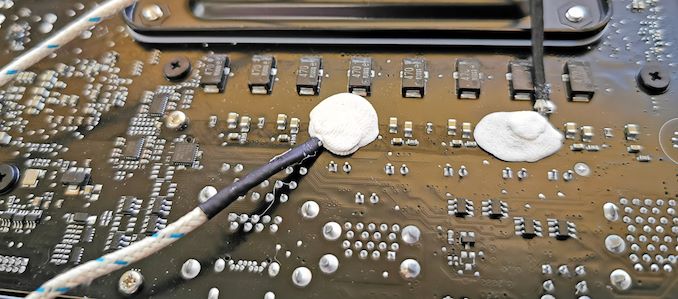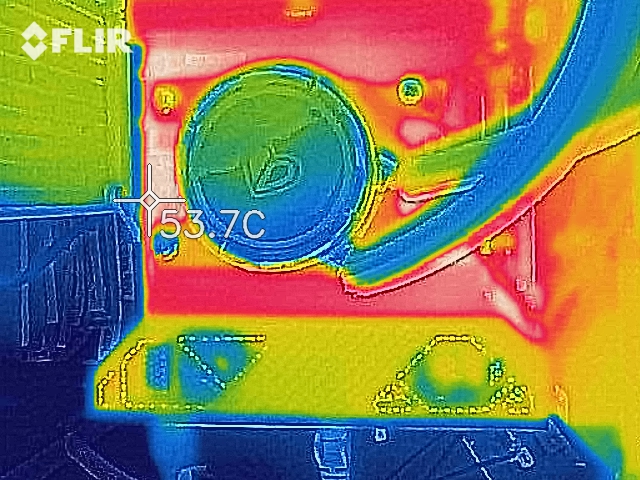The ASUS ROG Crosshair VIII Impact: A Sharp $430 Impulse on X570
by Gavin Bonshor on October 25, 2019 11:30 AM ESTPower Delivery Thermal Analysis
One of the most requested elements of our motherboard reviews revolves around the power delivery and its componentry. Aside from the quality of the components and its capability for overclocking to push out higher clock speeds which in turn improves performance, is the thermal capability of the cooling solutions implemented by manufacturers. While almost always fine for users running processors at default settings, the cooling capability of the VRMs isn't something that users should worry too much about, but for those looking to squeeze out extra performance from the CPU via overclocking, this puts extra pressure on the power delivery and in turn, generates extra heat. This is why more premium models often include heatsinks on its models with better cooling designs, heftier chunks of metal, and in some cases, even with water blocks such as the ASUS ROG Crosshair VIII Formula.

Two K-Type Thermal Probes attached to the rear of the power delivery on the ASUS ROG Crosshair VIII Impact
Testing Methodology
Out method of testing out if the power delivery and its heatsink are effective at dissipating heat, is by running an intensely heavy CPU workload for a prolonged method of time. We apply an overclock which is deemed safe and at the maximum that the silicon on our AMD Ryzen 7 3700X processor allows. We then run the Prime95 with AVX2 enabled under a torture test for an hour at the maximum stable overclock we can which puts insane pressure on the processor. We collect our data via three different methods which include the following:
- Taking a thermal image from a birds-eye view after an hour with a Flir Pro thermal imaging camera
- Securing two probes on to the rear of the PCB, right underneath CPU VCore section of the power delivery for better parity in case a probe reports a faulty reading
- Taking a reading of the VRM temperature from the sensor reading within the HWInfo monitoring application
The reason for using three different methods is that some sensors can read inaccurate temperatures, which can give very erratic results for users looking to gauge whether an overclock is too much pressure for the power delivery handle. With using a probe on the rear, it can also show the efficiency of the power stages and heatsinks as a wide margin between the probe and sensor temperature can show that the heatsink is dissipating heat and that the design is working, or that the internal sensor is massively wrong. To ensure our probe was accurate before testing, I binned 10 and selected the most accurate (within 1c of the actual temperature) for better parity in our testing.
For thermal image, we use a Flir One camera as it gives a good indication of where the heat is generated around the socket area, as some designs use different configurations and an evenly spread power delivery with good components will usually generate less heat. Manufacturers who use inefficient heatsinks and cheap out on power delivery components should run hotter than those who have invested. Of course, a $700 flagship motherboard is likely to outperform a cheaper $100 model under the same testing conditions, but it is still worth testing to see which vendors are doing things correctly.
Thermal Analysis Results

We measured 53.7°C on the hottest part of the board during our testing, the PCB around the VRMs
The ASUS ROG Crosshair VIII Impact is using a 10-phase power delivery with eight Infineon TDA21472 70 A power stages and two TDA21472 70 A power stages for the SoC which are mounted onto the rear of the PCB. The PWM controller of choice is the ASP1405I running in a 4+2 configuration but without doublers. Cooling on the power delivery is expansive with an actively cooled heatsink that has a 30 mm fan integrated into the rear panel cover, and also included a backplate on the rear which incorporates a slim heat pipe into its design. For a small form factor model, this is pretty comprehensive as both the front-mounted CPU section and rear-mounted SoC power stages all have some form of thermal reducing properties to maximise performance.
The results from our power delivery thermal testing put the ASUS ROG Crosshair VIII Impact in good stead for overclockers looking to use this board for high-performance systems. When directly compared to the other small form factor X570 model we've tested, the ASRock X570 Phantom Gaming-ITX/TB3, the Impact power delivery runs around 8°C cooler when comparing the integrated VRM temperature sensors. The performance can be attributed to the small 30 mm cooling fan over the top of the power delivery heatsink, as well as the backplate with a heat pipe integrated negating heat from the front and back. Our external probe reading does seem a little low with a reading of 49°C when compared with previous models on test, but the more heat the heatsinks can remove, the lower the probe temperature should be. The power delivery cooling solution makes the ROG Crosshair VIII Impact the most equipped small form factor board we've seen so far for overclocking Ryzen's 3000 series of processors, and with its high $430 price tag, we wouldn't expect anything less than best-in-class performance; the ASUS ROG Crosshair VIII Impact, in this instance, is certainly that.











59 Comments
View All Comments
Marlin1975 - Friday, October 25, 2019 - link
Nice board; but not $200, let alone $400, nice.Destoya - Friday, October 25, 2019 - link
This is really a hardcore overclocker board more than anything and the price reflects that. It's already set records for DRAM frequency (first board over 6000 MT/s).As the article says, there's numerous other options for SFF X570/X470 at more reasonable prices for people who aren't chasing WR overclocks or who don't have a blank check to build the "best" small system.
shabby - Friday, October 25, 2019 - link
How much better will this overclock than a $200 board? 50mhz more? The new ryzen chips simply don't overclock well so you don't need any fancy mobos.Dug - Friday, October 25, 2019 - link
More for ram than cpu. You are right, the ryzen cpu's just don't o/c that much to spend so much money on this board. The differences in speed aren't worth the headache.TheinsanegamerN - Sunday, October 27, 2019 - link
My crosshair VII was only $249 and it is considered a fantastic OC AMD board with overbuilt VRM capable of OCing memory well as long as the CPU can handle it.$400 is WAY too much for a tiny mobo that wont OC ryzen 3000 any higher then your typical AM4 board, on account of ryzen 3000 having 0 OC headroom, and even if it did, you dont need a $400 mobo to do that.
This generation motherboards have jumped $100-200 in price while prancing out touted features that mean jack in real world usage. People need to stop wasting their money on this overpriced garbage.
guitarmassacre - Friday, October 25, 2019 - link
In what world would this board sell for sub-$200? The cheapest itx is currently $220.evernessince - Saturday, October 26, 2019 - link
Given that X99 SFF boards sell for more then $200 and they have less PCIe bandwidth and a lower PCIe version, older Wifi, older USB gen, ect. I don't see a reason why this board wouldn't be worth more then $200. If people can justify paying Intel's premium for 3% more gaming performance, you can certainly justify twice the PCIe speed.Daveteauk - Monday, May 18, 2020 - link
$200?!? You are a dreamer! What colour is the sky in your world!?Sivar - Friday, October 25, 2019 - link
Yet another X570 with an embedded fan. Pass.This is a regression, from solid state to mechanical moving parts. Fan quality has increased since the horror stories of the 90's and 2000's, but an improved bad idea is still a bad idea.
Why can only Gigabyte cool an 11W load passively?
PeachNCream - Friday, October 25, 2019 - link
It actually has two 30mm fans rather than one.